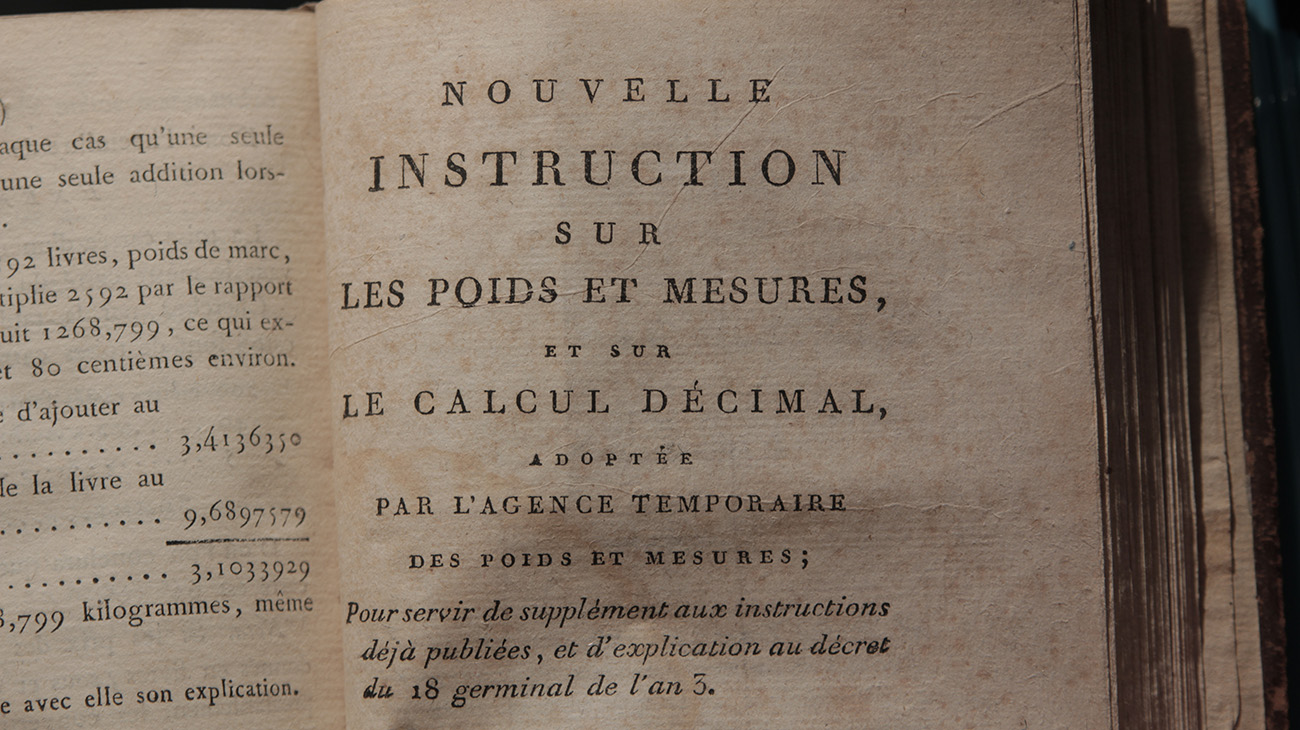October 23, 2016
Metrication in 1790s France: When people got what they asked for, but not what they wanted
Facing a national crisis exacerbated by debt from helping the American Colonies fight a war of independence, political gridlock, and a failed harvest, King Louis XVI did something his ancestors had not done since 1614---called together the national governing body, Estates-General. To prepare for their convocation in May 1789, the King invited everyone from all provinces of France submit their complaints about the nation's problems, and recommendations how to fix these problems. These complaints were typically drafted at the village or city scale, and were called primary cahiers. General cahiers were written by higher levels of government representatives and taken to the convocation in Versailles. These documents are collectively called the cahiers de doléances. Historians estimate at least 20,000 primary cahiers were written in the spring of 1789, authored by legislative groups, trade guilds, clergy, aristocracy, and citizens of municipalities. (For details about the history of the cahiers de doléances, and the conditions leading to their creation, see Shapiro et al p. 100-114, and Hyslop, p. vii ff.)
The complaints and wishes spanned aspects of all levels government, from how often the Estates General should meet, to whether the local lord could keep doves. In principle the general cahiers were to summarize the local interests, but the two are quite different in scope. (Shapiro, p 117) Weights and measures were mentioned with such fundamental topics of government as taxes, personal liberties, and the judiciary system.
Peasants complained that a lack of standards and oversight allowed landowners to manipulate weights and measures when collecting their share of the harvest. Disorganized weights and measures were a frequent complaint in cahiers submitted by trade guilds because it hindered commerce. For some examples, let us look at some cahiers of the city of Angers.
The tailors wrote, "On demande qu'il ne puisse y avoir que mêmes poids et mesure et aunages par tous les lieux du royaume, qu'une même loi et même coutume, s'il était possible." ("We demand that there be same weights and same measure thoughout the royal kingdom, like one law and one custom, if possible.") The farriers ("horse-shoers") and locksmiths had a similar request, "Demandon même poids, même mesure, même lois." And in the city-level cahier in the "Commerce" section, "Il y aura même poids et même mesure dans tout le royaume, et même titre pour l'or et l'argent." ("There would be the same weights, the same measure throughout the kingdom, and the same for gold or silver.")
So, how much did people complain about their weights and measures? A ranking of topics based on data analysis (Shapiro et al, p 381) shows that in the cahiers of the Third Estate, weights and measures are 14th out of 50, between "allocation of taxes" and "personal liberties." (To be precise, one cannot say that the Third Estate comprised only non-clergy, non-nobility.) A common phrasing was "Même poids, même mesure, même lois dans tous le royaume." ("Same weights, same measures, same laws throughout the kingdom.")
"Weights and Measures" is #39 out of 50 in the parish cahiers. Although 39 of 50 may not seem terribly prominent, 16 of the 50 subjects deal with taxes (1, 2, 3, 5, 10, 11, 17, 21, 22, 26, 32, 33, 35, 43, 47, 48.) Nine subjects relate to privileges of the nobility (11, 14, 25, 27, 26, 29, 33, 34, 50.) And note that "Praise of Louis XVI" (he was still the king, after all) is only the ninth topic.
After the Revolution, the French government gave the people what they had asked for: standardized weights and measures. One of the propositions of the National Assembly (1790) about weights and measures discussed the variety and mismatched names as a source of confusion, and a hindrance to commerce:
"L'innombrable variété de nos poids & de nos mesures & leurs dénominations bisarres jettent nécessairement de la confusion dans les idées, de l'embarras dans le commerce. Mais ce qui particulièrement doit être une source d'erreurs & d'infidélités, c'est moins encore cette diversité, en elle-même, que la différence des choses sous l'uniformité des noms."
(Source: Proposition Faite A l'assemblée national sur les poids et mesures, par M. Lévéque D'autun. A Paris, de l'Imprimerie National, 1790. Also on two Google Books, one of which attributes it to Tallyrand.)
To improve the system of weights and measures, the Republican government enlisted the expertise and judgment of scientists, who had been esteemed for providing rational and effective solutions to practical problems of governing. Laplace, Lagrange, Legendre, Condorcet, and Monge were all part of committees focused on creating a new standardized measurement system for France, and indeed, for the whole world. (For details about the role of the Academy and top scientists in government, see The Anatomy of a Scientific Institution: The Paris Academy of Sciences, 1666-1803, by Roger Hahn, 1971.)
What the mathematicians came up with was not a standardization of existing units. It was an entirely new system of weights and measures. (Vera, p 47) The mathematicians didn't base these measures upon the most common units used in Paris, as was recommended often in the cahiers. Rather they created new units based on up-to-date scientific experiments (For details, see Riordan, p v. Also, Michael Trott insists that I add details about the experiments because there are no space limits on blog entries: The basic unit of length was based on the length of the meridian through Paris. Area and volume units would be based on the length unit. The connection to mass units would be realized through the density of pure water.) The units had new names like mètre, based on Greek and Latin words. The system also introduced prefixes like "deci" and "kilo" when quantities grew or shrank, instead of calling the quantity something else, like a "gallon" which is equal to eight pints. The new names, combined with two-syllable prefixes were long, foreign and thus unpopular with the French populace. (Champagne, 175).
But none of these innovations had been requested in the cahiers de doléances. People had asked for standardized measures to ease commerce, prevent cheating, and ensure equality before the law.
It's true, that the fractional math needed to do business with so many units and number systems was complicated. "The need for a uniform system of weights and measures in eighteenth-century France stemmed from three main sources: the diversity in the number of existing units of measure, the abuses and frauds that were engendered by this diversity, and the complex calculations that resulted in commercial transactions where there was a need to compare quantities bought or sold using different standards." (Champagne, p 124)
Decimal weights, measures, and currency were not novel among France's top scientists of the times. In 1754, d'Alembert advocated for decimal weights and measures in the Encyclopédie entry for "Decimal." (Vera, p 31) And Borda, Lagrange, Lavoisier, Tillet and Condorcet recommended decimal divisions for currency in a report delivered October 1790.
Decimal arithmetic was viewed by these top mathematicians as easier to learn and use therefore better suited for the general public. And they were able to base their opinions on teaching experience and a deep consideration of what a capable, informed citizenry should know. Condorcet developed a "public instruction" plan in 1792. Laplace taught at the École Normale. (Champagne, 139) The mathematicians also had practical knowledge of emerging technologies. "The mathematicians are called upon to examine and report on inventions, instruments, manuscripts, proposals, experiments, government requests, work of correspondents or foreign scholars, and published works related to the metric system." And Lagrange was a judge of a competition for decimal clocks in 1794. (Champagne, p 117, 474)
So the mathematicians took the opportunity to introduce base-10 arithmetic to calculate with new units. "…Decimalization became incorporated, not to say smuggled, into the metric reform as a corollary of the law of 26 March 1791 basing the system on the measurement of the meridian." (Gillispie, 243-244)
To help the citizens understand the all-new measures and arithmetic they hadn't asked for, the French government initiated several programs to ensure adoption: sending new measurement standards to municipal offices and other public places, issuing fines for using old measures and forbidding the production of old measurement standards, and publishing educational materials.
Article 10 of the Decree of August 1, 1793 outlines the making of a book to instruct citizens on the new measures and decimal division:
"La Convention charge l'Académie de la composition d'un livre à l'usage de tous les citoyens, contenant des instructions simples sur la manière de se servir des nouveaux poids et mesures, et sur la pratique des opérations arithmétiques relatives à la division décimale." (The whole decree is reprinted on Google books in a British report on the introduction of the metric system into the UK, G.E. Eyre and W. Spottiswoode, 1869.)
And here is one of these books, from the collection of Michael Trott.
While I use the word "book," it's really six smaller works bound together under the title "Nouvelle Mesures."
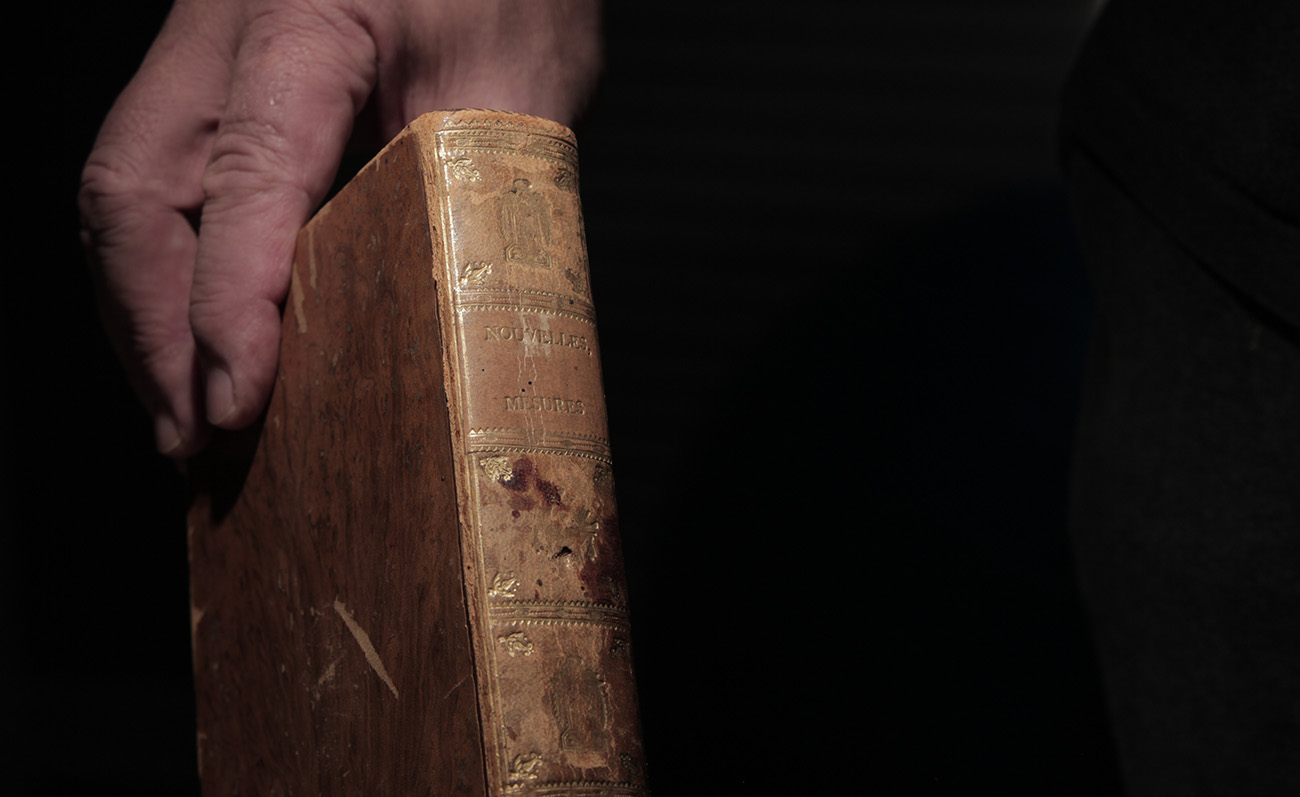
The title pages give publications dates spanning Year III to Year IX or September 22,1793 to September 22, 1801. Note that Decree of 1793 uses the name "grave" for the unit of weigh-you can see it on page 57. (Source: Décret relatif aux poids et aux mesures du 18 germinal an 3 (7 avril 1795)).
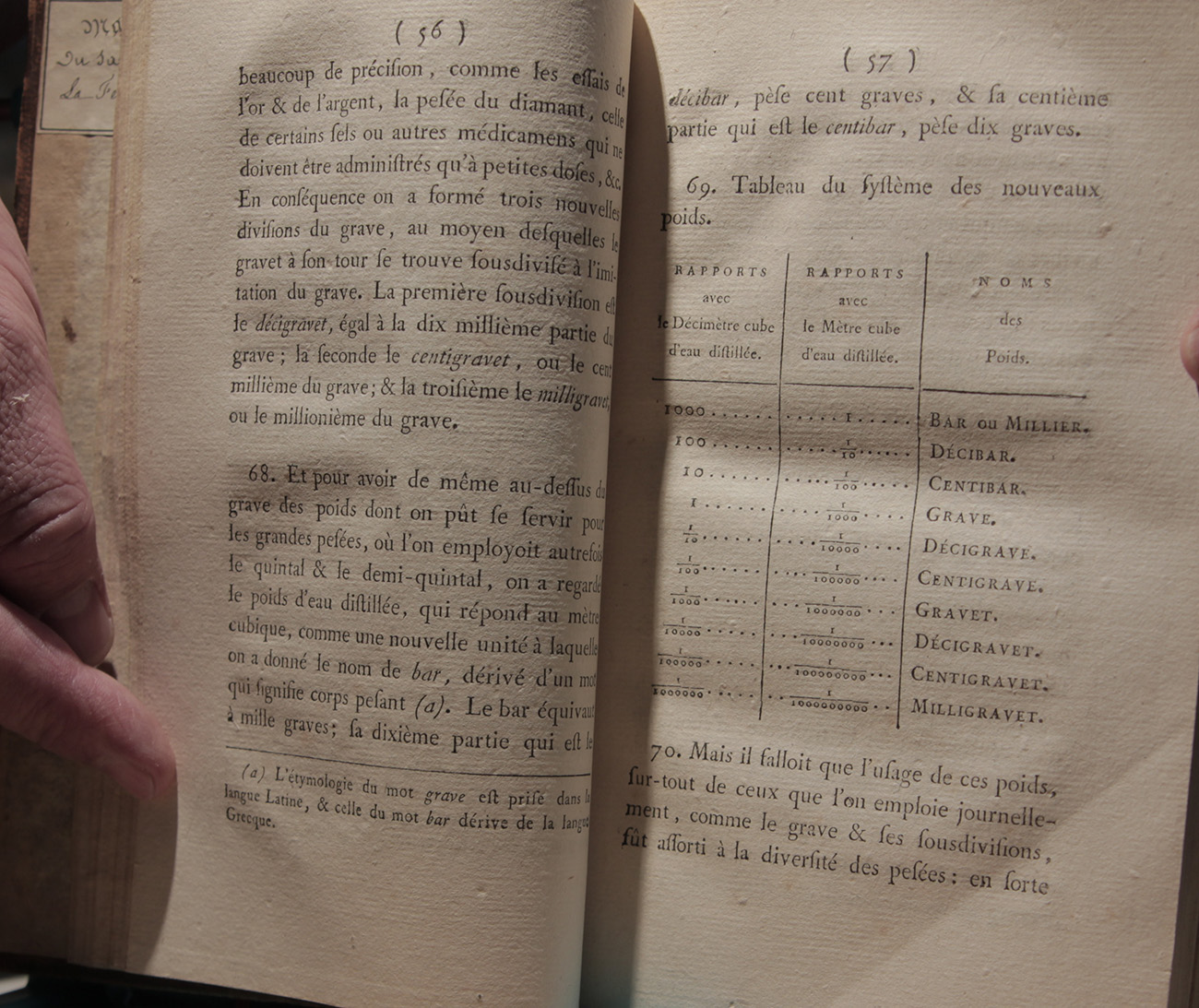
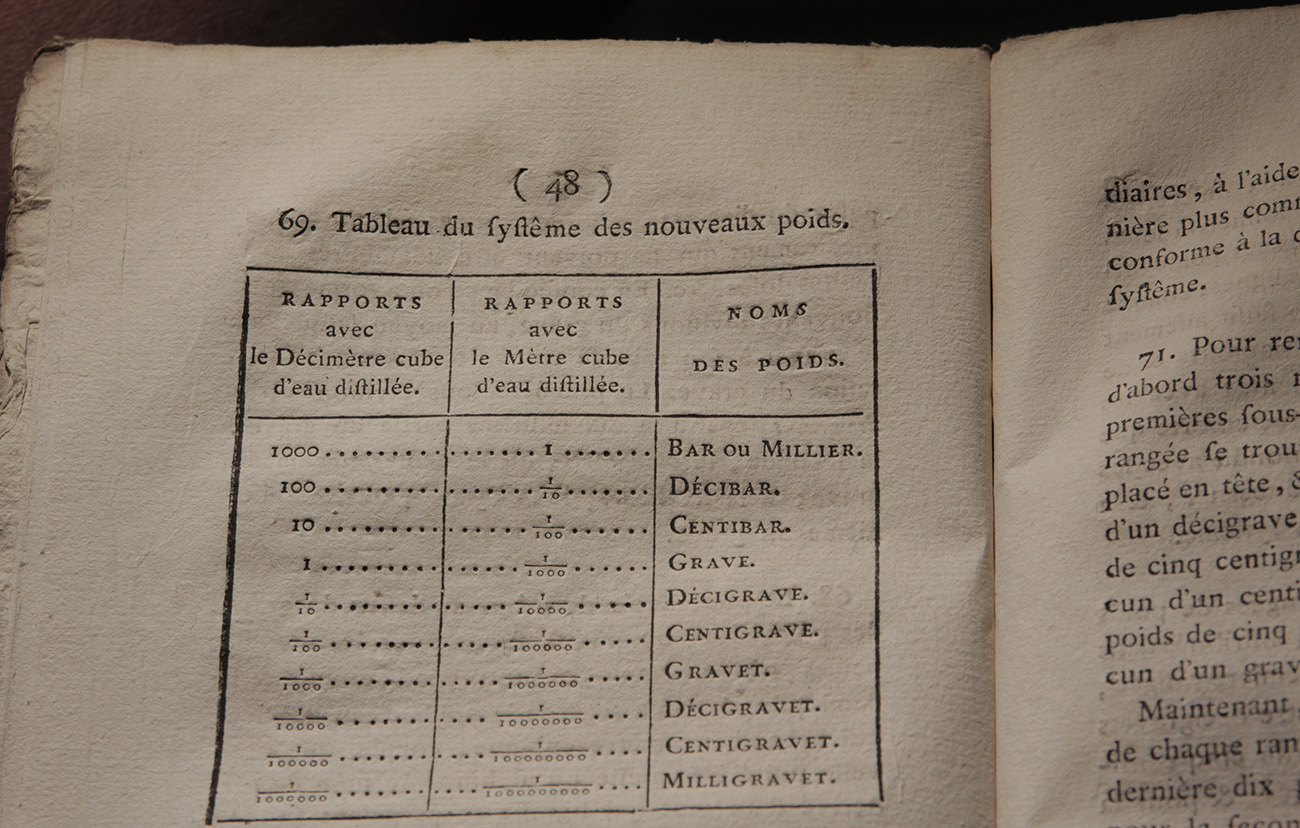
By the Decree of April 8, 1795, the word "gramme" is the name for the unit of weight. So I conclude that this book was initiated by the 1793 Decree, but printed before the 1795 Decree, about 27 months later.
The large chart in the one of the books uses "Gramme."

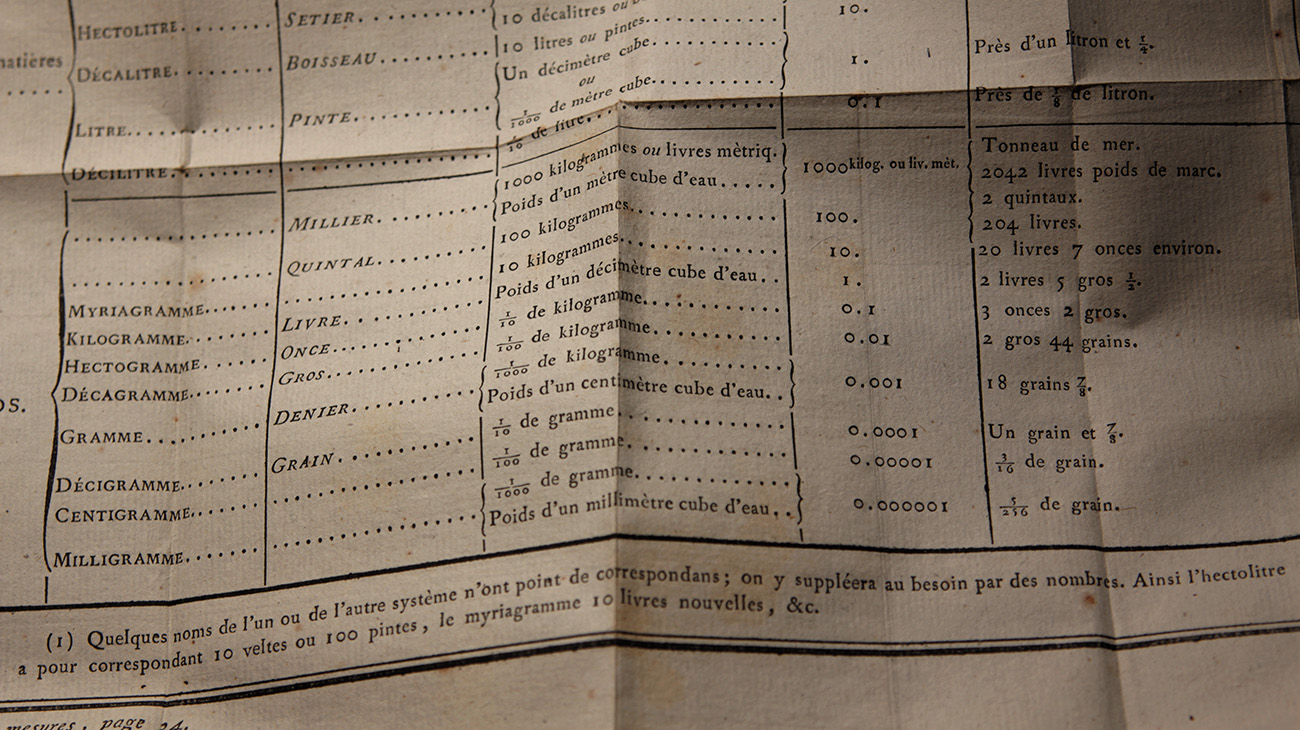
The hassle of early adoption was cast as a sign of national solidarity in the Decree of April 1795, "…Les citoyens sont cependant invités de donner une preuve de leur attachement à l'unité et à l'indivisibilité de la République en se servant dès à présent des nouvelles mesures dans leurs calculs et transactions commerciales." ("…citizens are invited, however, to give proof of their devotion to unity and indivisibility of the Republic by making use of the new measures henceforth in their calculations and commercial transactions.") (Source: Grandes lois de la République, Decree of April 7, 1793)
The title pages list publication in different cities including Paris, Caen, and Dijon. The title pages do not list who wrote the books. Indeed, the books reflect the communal focus, and don't list any names of person, just committees and decisions. The books also include a timeline of decrees and key decisions regarding weights and measures.
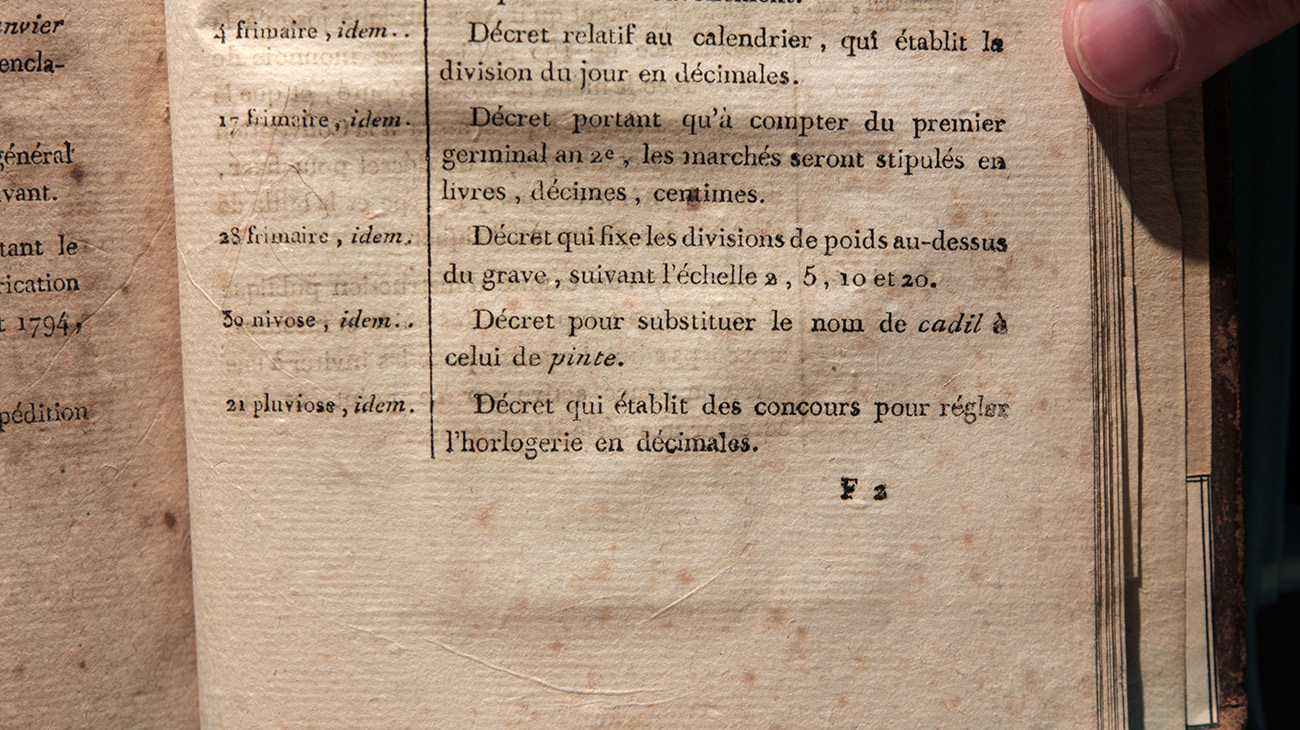
While it's not clear that any math-celebrities like Lagrange or Laplace wrote these, the books' authors do include such top-notch scientists as René Just Haüy, a metallurgist who performed water-weighing experiments with Lavoisier to determine the new kilogram (Riordan, p 70) and Claude Antoine Prieur-Duvernois, a military engineer who later helped found the École Polytechnic (Ross, p 131).
The metric system would also be taught in schools by math-celebrities. "Lagrange and Laplace both indicate to their students in lectures on the metric system that it will be treated 'with the detail appropriate to its importance'…" (Champagne, p 37)
Within the books are printed length measures, so the reader could check their own small measuring sticks. (You may recall that meter sticks in Paris could be checked against the 16 stone and brass métre-étalons mounted throughout the city in 1796-1797.)

The books also explained decimal arithmetic in general:
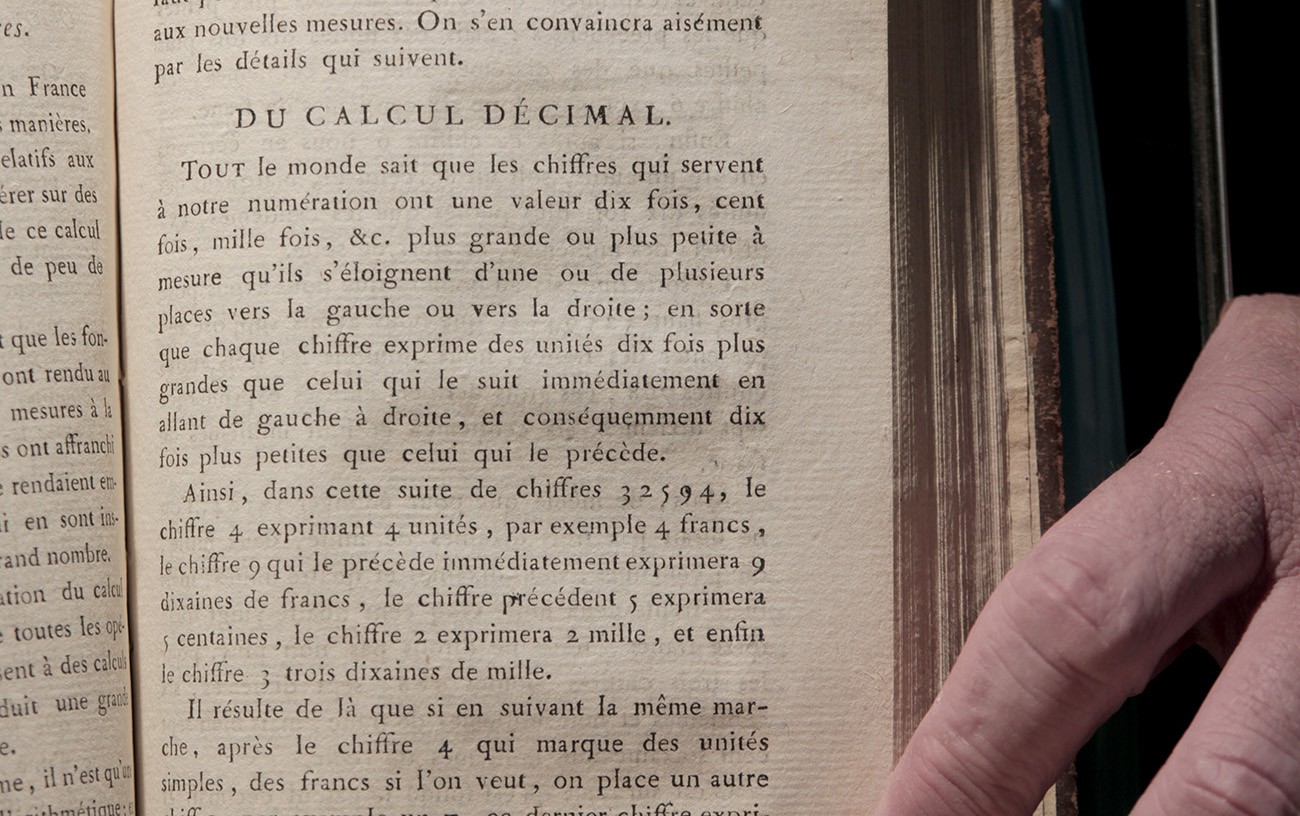
and gave some decimal equivalents for fractions.
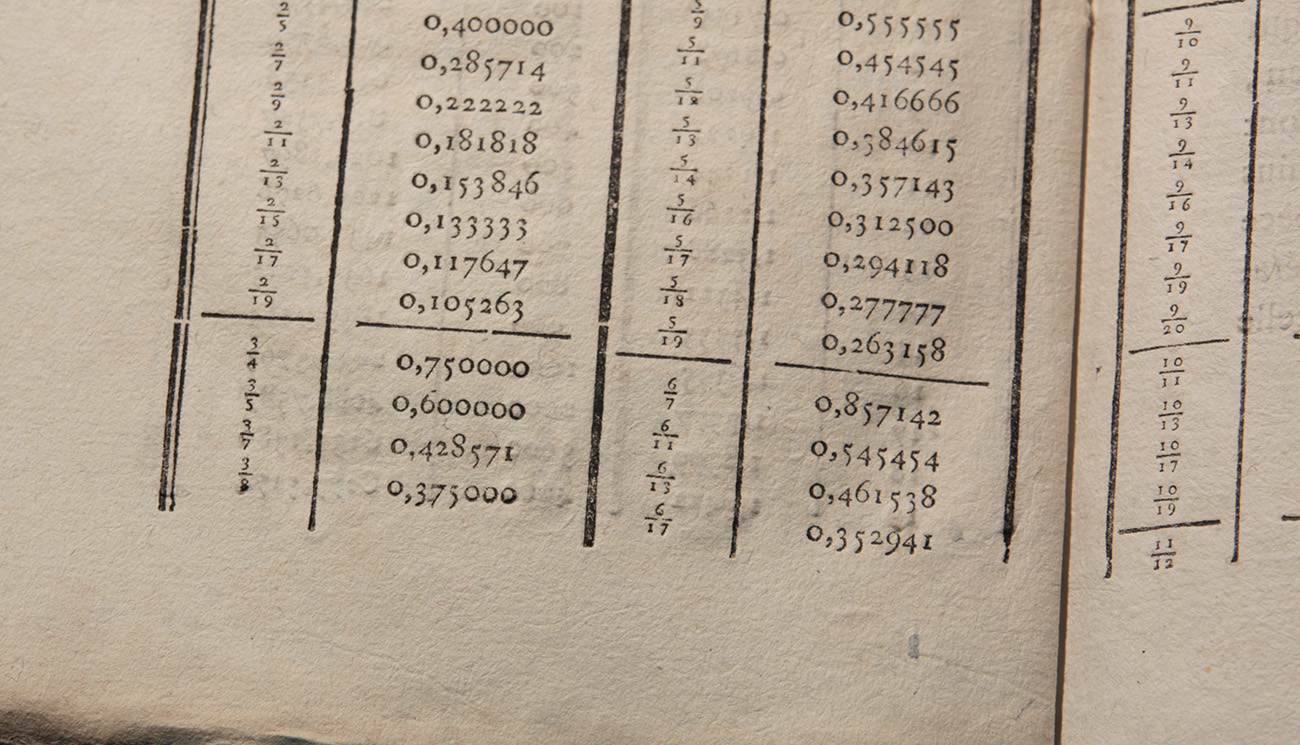
The books included conversions between the meter and older units: toise, pied, pouce, and ligne.

At the end ("FIN") the book does connect the new measures specifically to the Paris measures, as the cahiers had asked for.
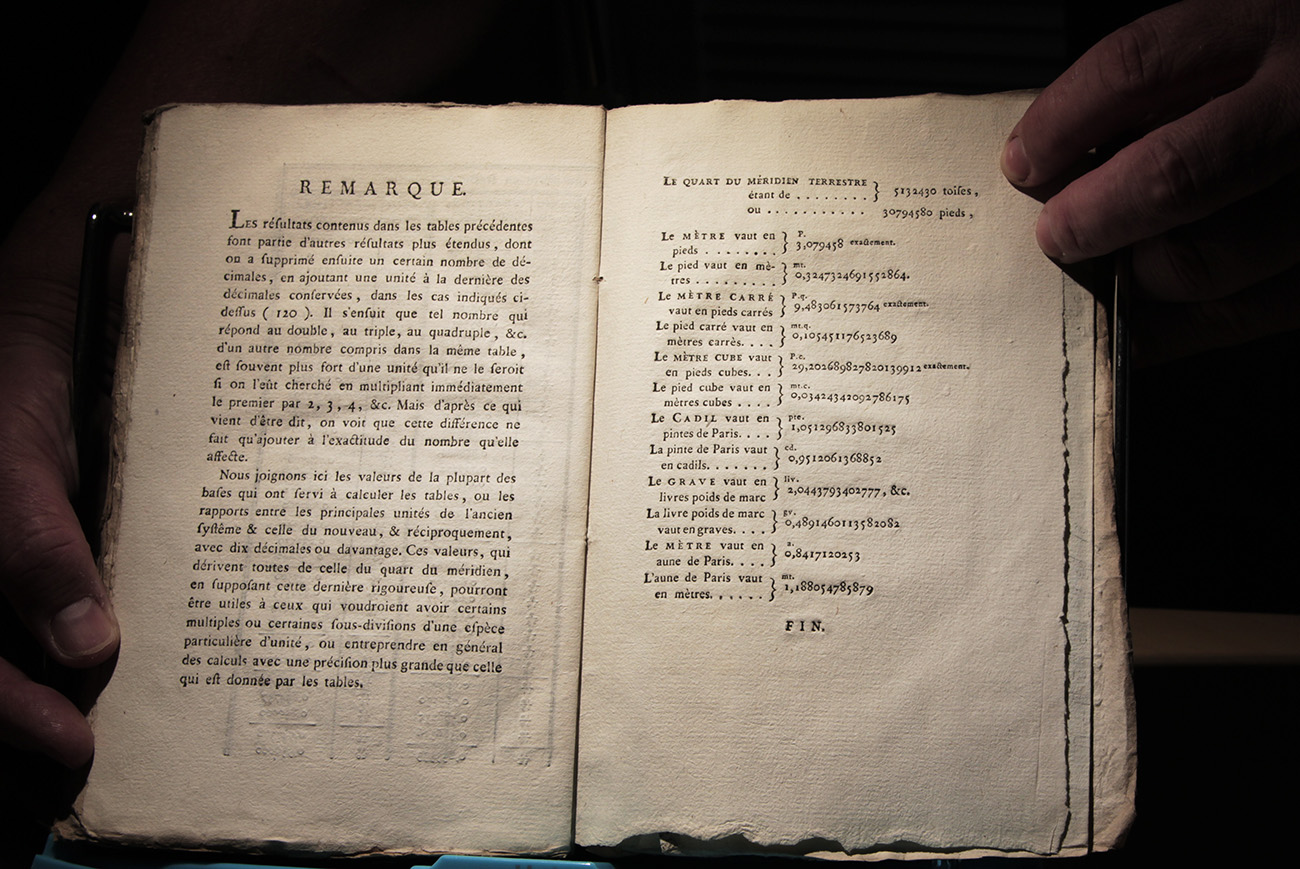
What I don't know is how many of these books were printed, how they were used, and if they were used. Did they print 1 per 100 people? (They had censuses in France back in 1793.) Were they available at the municipal offices to be checked out like library books? Were they piled in boxes at the post office like tax forms?
However these instructions were distributed and read, the metric system would be in limbo for 50 years in France, until Louis Philippe passed the law in 1837 for the "full establishment of the metric system in 1840."
One important difference between the introduction of the metric system in 1790 and the 2018 revising of the SI is who will "feel" the change. The new kilogram will not change the measures the average citizen uses to bake an average cake.
Sources:
- Champagne, Ruth Inez. The Role of Five Eighteenth Century French Mathematicians in the Development of the Metric System. PhD dissertation, Columbia University. 1979.
- Département de Maine-et-Loire. Cahiers de doléances des corporations de la ville d'Angers et des paroisses de la sénéchaussée particulière d'Angers pour les États généraux de 1789, annotés et précédés d'une introd. LeMoy, Arthur. Published: Angers, Impr. A. Burdin, 1915-1916. https://babel.hathitrust.org/cgi/pt?id=mdp.39015026111792;view=1up;seq=9, p143, 159.
- Gillispie, Charles Coulston. Science and Polity in France The Revolutionary and Napoleonic Years. 1998.
- Hyslop, Beatrice Fry. A Guide to the General Cahiers of 1789: With the Texts of Unedited Cahiers. Octagon Books. 1936.
- Kula, Witold. Measures and Men. Princeton University Press.1982.
- Riordan, Sally. The Making of the Kilogram, 1789-1799. PhD thesis, Stanford University. 2013.
- Ross, Steven T. The A to Z of the Wars of the French Revolution. 2010.
- Shapiro, Gilbert & Timothy Tackett, Philip Dawson, John Markoff. Revolutionary Demands: A Content Analysis of the Cahiers de Doléances of 1789. Stanford University Press. 1998.
- Vera, Hector. KronoScope 9.1-2. 2009.
